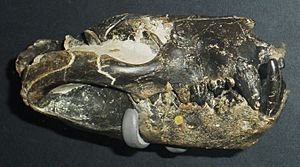Borhyaena facts for kids
Quick facts for kids Borhyaena |
|
|---|---|
 |
|
| B. tuberata skull | |
| Scientific classification |
|
| Kingdom: | Animalia |
| Phylum: | Chordata |
| Class: | Mammalia |
| Order: | †Sparassodonta |
| Family: | †Borhyaenidae |
| Genus: | †Borhyaena Ameghino 1887 |
| Species | |
|
|
| Synonyms | |
|
|
Borhyaena was an extinct animal that lived in South America about 20 to 15 million years ago. It was a type of ancient mammal known as a metatherian, which means it was related to modern marsupials like kangaroos and opossums.
Borhyaena was a powerful meat-eater, similar to a wolf or a hyena in how it lived and hunted. It was one of the top predators in its environment during the Miocene epoch.
Contents
What Was Borhyaena?
Borhyaena was a genus of extinct mammals called sparassodonts. These animals were very important predators in South America before other types of meat-eating mammals arrived. They filled the role that large carnivores do today.
Scientists believe Borhyaena was a strong and muscular animal. It had a large head with powerful jaws and teeth. These features helped it to hunt and eat other animals.
Where and When Did It Live?
Borhyaena lived in South America during a time called the Miocene epoch. This was roughly between 20 and 15 million years ago. During this period, South America was an island continent, meaning it was separated from other landmasses.
Because it was an island, unique animals evolved there. Borhyaena was part of this special group of South American animals. Its fossils have been found in countries like Argentina and Chile.
How Did It Hunt?
Borhyaena was a skilled hunter. Its strong body and powerful bite suggest it could take down fairly large prey. It likely hunted other native South American mammals that lived at the same time.
Like many predators, Borhyaena probably used its sharp teeth to grab and kill its prey. Its strong jaws would have helped it crush bones and eat all parts of its meal.
Discovery of Borhyaena
The first fossils of Borhyaena were discovered in South America. They were described by a famous Argentine paleontologist named Florentino Ameghino in 1887. He was one of the first scientists to study the ancient animals of South America.
Ameghino's work helped us understand what life was like millions of years ago on the continent. The discovery of Borhyaena showed that South America had its own unique group of large predators in ancient times.
Images for kids
See also
 In Spanish: Borhyaena para niños
In Spanish: Borhyaena para niños


